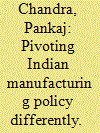| Srl | Item |
| 1 |
ID:
138115


|
|
|
|
|
| Summary/Abstract |
The policy debate on manufacturing in India often gets confounded by a poor articulation of its objectives and by a weak rationale for its industrial structure. The 2013 Economic Survey of India put its finger neatly on one of the objectives and a key issue at stake here—the extent and quality of employment1—though the UPA2 government could not implement its own manufacturing policy during its tenure. That a robust manufacturing helps build deep technological capabilities in our society, thereby making the nation strategically strong, escapes much of our policy thinking. Whether the NDA3 government’s “Make in India” plan will change the face of India (a potential that exists) or will it just remain a slogan of intent will depend, to a large extent, on our understanding of the second aspect of the policy confusion in manufacturing—why do we do, what we do and how we do it—the rationale behind the our industrial structure and the resulting competitiveness or lack of it.
|
|
|
|
|
|
|
|
|
|
|
|
|
|
|
|
| 2 |
ID:
168508


|
|
|
|
|
| Summary/Abstract |
Over the years, researches have witnessed incongruence nature and direction of relationship among product market competition and firm size with the growth of firms’ productivity across the globe. Considering these gaps, this study aims to establish both short- and long-run relationships among these three characteristics of Indian manufacturing firms and intends to find their directions of causalities. This study uses firm-level data over a period of 1998–1999 to 2012–2013. Using Panel ARDL-PMG method, the results reveal the existence of a long-run association among product market competition, firm size and productivity growth for the full sample and for subsamples, categorizing relatively efficient and inefficient firms, and innovative and non-innovative firms. From the panel VECM Granger causality test, it has been observed that there is the long-run feedback relationship among these three variables. The empirical evidence suggests that as the intensity of competition becomes stronger and the firm-specific capabilities expand, they impart improved productivity via within and between firm effects. This draws some major implications for policymakers to embrace more competitive prone policies along with encouragement to firm specificities to realise value-added productivity.
|
|
|
|
|
|
|
|
|
|
|
|
|
|
|
|